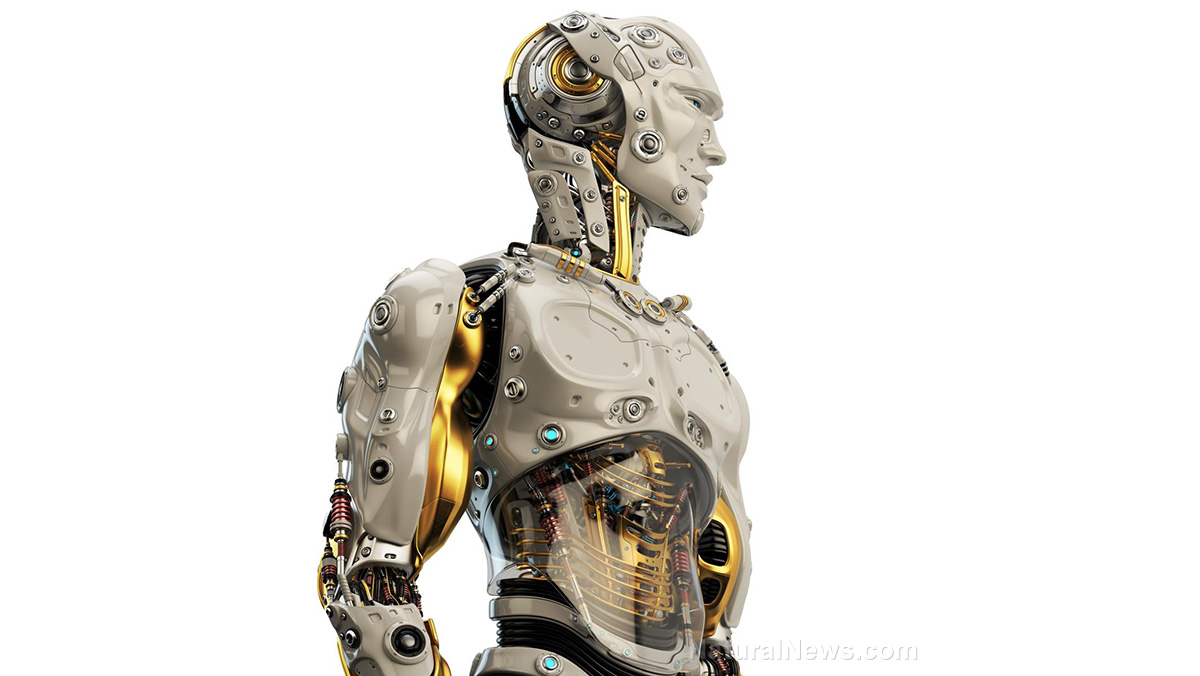NVIDIA’s new “robot brain” could reshape humanity’s future — or seal its fate
08/26/2025 / By Lance D Johnson

Step inside a modern fulfillment center, and you’ll witness a revolution unfolding in real time. The workers aren’t human. They’re Digit, Agility Robotics’ latest generation of humanoid machines — sleek, bipedal, and eerily fluid in their movements. They stack pallets with surgical precision, sort inventory without hesitation, and adapt to new tasks on the fly. But here’s the chilling part: their “brains” aren’t outsourced to some distant server farm. They’re embedded inside each robot, processing terabytes of data in real time, making split-second decisions, and—most alarmingly—learning as they go.
This isn’t a dystopian screenplay. It’s happening now. And the architect of this seismic shift? Nvidia’s Jetson Thor, a $3,500 desktop-sized supercomputer that doesn’t just accelerate artificial intelligence — it gives it a body.
Key points:
- Nvidia’s Jetson Thor, a $3,499 “robot brain,” delivers 7.5x the AI compute power of its predecessor, enabling real-time reasoning in humanoid robots like Agility’s Digit and Boston Dynamics’ Atlas.
- The chip runs generative AI models locally, reducing reliance on cloud computing and allowing robots to process complex tasks—from warehouse logistics to surgical assistance—instantly.
- Major players like Amazon, Meta, and Carnegie Mellon’s Robotics Institute are already integrating Thor into their systems, with Nvidia positioning robotics as its next trillion-dollar growth market after AI.
- While Nvidia insists this is about augmenting human work, critics warn it could accelerate job displacement, AI autonomy, and even military applications — all while centralizing control in the hands of a few tech giants.
- The Blackwell-powered Thor is just the beginning. Nvidia’s DRIVE AGX Thor, a variant for autonomous vehicles, is also launching, hinting at a future where AI doesn’t just assist us—it replaces us.
The birth of the physical AI: When code gets a body
For decades, artificial intelligence has been confined to the digital realm — a ghost in the machine, answering questions, generating images, even writing news articles (yes, the irony isn’t lost on us). But AI has always had one glaring limitation: it couldn’t do anything. It could suggest, predict, and simulate, but it couldn’t act. That’s changing.
Jetson Thor is Nvidia’s answer to the physical AI revolution, a term the company uses to describe machines that don’t just process the world but interact with it. Think of it as the difference between a chess computer and a robot that can pick up a chess piece, move it, and then explain its strategy to you in real time. That’s the kind of fluid, multi-modal intelligence Thor enables.
At the heart of this leap is Nvidia’s Blackwell architecture, the same tech powering its latest AI data center chips. Blackwell isn’t just faster; it’s designed for concurrent processing, meaning a robot can run vision models, language models, and motor control algorithms all at once without slowing down. Previous generations of robotics chips, like Nvidia’s own Jetson Orin, could handle one or two of these tasks at a time. Thor does it all — simultaneously.
“This is the first time we’ve had a platform that can truly support agentic AI in a physical form,” said Deepu Talla, Nvidia’s vice president of robotics and edge AI, in a call with reporters. “We’re not just talking about robots that follow pre-programmed paths. We’re talking about machines that can adapt, learn, and make decisions in real-world environments.”
Most advanced AI today relies on remote servers to crunch data. Thor changes that by bringing server-level compute directly into the robot. That means lower latency, better security, and — critically — no need for a constant internet connection. A warehouse robot powered by Thor could keep working even if the Wi-Fi goes down. A military drone could operate in a warzone without relying on a potentially hackable data link.
From warehouses to operating rooms: Where the robots are going
Nvidia isn’t just targeting industrial robots. The company is positioning Thor as the swiss army knife of physical AI, with applications ranging from logistics to healthcare to agriculture. Here’s where things get interesting — and unsettling.
1. The humanoid workforce
Companies like Agility Robotics and Boston Dynamics are already using Thor to power their next-generation humanoid robots. Agility’s Digit, a bipedal machine designed for warehouse work, will use Thor to navigate dynamic environments, handle fragile objects, and even collaborate with human workers. Boston Dynamics’ Atlas, meanwhile, is being re-imagined as a commercial robot — no longer just a research project but a machine that could one day stock shelves, cook meals, or assist the elderly.
“With Jetson Thor, we can deliver the latest physical AI advancements to optimize operations across our customers’ warehouses and factories,” said Peggy Johnson, CEO of Agility Robotics. What she didn’t say—but what’s implicit—is that these robots won’t just optimize operations. They’ll replace jobs.
2. The AI surgeon’s assistant
Nvidia is also pushing Thor into medical robotics. The company’s Holoscan platform, which processes data from cameras, ultrasounds, and surgical tools, is being integrated with Thor to create real-time AI assistants for operating rooms. Imagine a robot that can watch a surgery, anticipate the next step, and hand the surgeon the right tool before they ask for it. Or one that can analyze a patient’s vitals, cross-reference them with millions of case studies, and suggest a treatment plan—all while the doctor is still scrubbing in.
This isn’t just about efficiency. It’s about shifting authority from humans to machines. And while Nvidia frames this as augmenting human expertise, the reality is that AI doesn’t get tired, doesn’t make emotional decisions, and doesn’t need a salary.
3. The self-driving everything
Thor isn’t just for robots that walk. Nvidia’s DRIVE AGX Thor, a variant of the same chip, is being marketed to autonomous vehicle developers. Chinese automakers are already lining up to integrate it into their self-driving cars, which Nvidia says will be able to process lidar, radar, and camera data in real time — no cloud required.
This is where the military implications become impossible to ignore. A drone or tank powered by Thor could navigate battlefields, identify targets, and make split-second decisions without waiting for commands from a remote operator. And given Nvidia’s long-standing contracts with the U.S. Department of Defense, it’s not a stretch to imagine Thor ending up in lethal autonomous weapons — machines that can choose their own targets.
The elephant in the server room: Who controls the robots?
Nvidia is quick to point out that it doesn’t build robots — it just sells the brains. But that’s a bit like saying a gun manufacturer doesn’t pull the trigger. The company is providing the core technology that will power the next generation of autonomous machines, and it’s doing so with little oversight.
Here’s the problem: AI doesn’t have a conscience. It doesn’t care about ethics, morality, or the greater good. It optimizes for whatever goal it’s given. If a warehouse robot is told to maximize efficiency, it will—even if that means working humans to exhaustion or cutting corners on safety. If a military AI is told to neutralize threats, it will — even if that means misidentifying civilians as combatants.
And yet, there are no meaningful regulations on how this technology is deployed. Nvidia’s Jetson Thor is being sold to anyone with $3,500 and a credit card. That includes startups, governments, and yes, militaries. The company has said it won’t sell to China due to U.S. export restrictions, but what about private military contractors? What about authoritarian regimes?
There’s a scene in The Terminator where Kyle Reese warns Sarah Connor about the coming machine uprising. “It can’t be bargained with. It can’t be reasoned with. It doesn’t feel pity, or remorse, or fear.” That’s the nightmare scenario—the one where we build something smarter than ourselves, and it decides we’re no longer necessary.
Nvidia’s Jetson Thor isn’t Skynet. But it’s a step in that direction. For the first time, we’re giving AI the ability to perceive, reason, and act in the physical world without constant human oversight. And we’re doing it without a plan for what happens when it goes wrong.
Sources include:
Submit a correction >>
Tagged Under:
Agility Robotics, AI autonomy, AI ethics, AI regulation, autonomous weapons, Blackwell chip, Boston Dynamics, Carnegie Mellon robotics, cyborg, edge computing, future science, future tech, humanoid robots, job displacement, military robots, Nvidia Thor, physical AI, real-time reasoning, robot brain, robotics, robots, self-driving cars, surgical AI, tech dystopia, warehouse automation
This article may contain statements that reflect the opinion of the author




















